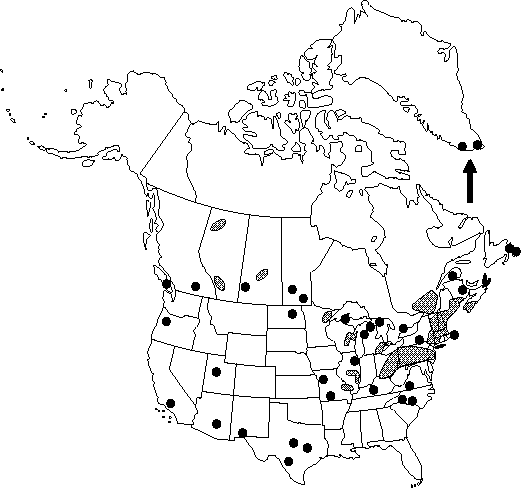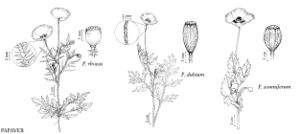Difference between revisions of "Papaver somniferum"
Sp. Pl. 1: 508. 1753.
FNA>Volume Importer |
FNA>Volume Importer |
||
| Line 34: | Line 34: | ||
|elevation=0-1300 m | |elevation=0-1300 m | ||
|distribution=Greenland;Alta.;B.C.;Man.;N.B.;Nfld.;N.S.;Ont.;Que.;Sask.;Ariz.;Calif.;Conn.;Ill.;Mass.;Maine;Mich.;Minn.;Mo.;N.H.;N.J.;N.Mex.;N.Y.;N.C.;N.Dak.;Ohio;Oreg.;Pa.;Tex.;Utah;Vt.;Va.;Europe;Asia. | |distribution=Greenland;Alta.;B.C.;Man.;N.B.;Nfld.;N.S.;Ont.;Que.;Sask.;Ariz.;Calif.;Conn.;Ill.;Mass.;Maine;Mich.;Minn.;Mo.;N.H.;N.J.;N.Mex.;N.Y.;N.C.;N.Dak.;Ohio;Oreg.;Pa.;Tex.;Utah;Vt.;Va.;Europe;Asia. | ||
| − | |discussion=<p>Unknown in the wild, Papaver somniferum probably came originally from southeastern Europe and/or southwestern Asia. It has been cultivated for centuries as the source of opium (and its modern derivatives heroin, morphine, and codeine), and also for edible seeds and oil. Various color forms with laciniate and/or doubled petals are grown for ornament. Widely introduced from cultivation and also as a crop weed, it should be expected elsewhere in the flora.</p> | + | |discussion=<p>Unknown in the wild, <i>Papaver somniferum</i> probably came originally from southeastern Europe and/or southwestern Asia. It has been cultivated for centuries as the source of opium (and its modern derivatives heroin, morphine, and codeine), and also for edible seeds and oil. Various color forms with laciniate and/or doubled petals are grown for ornament. Widely introduced from cultivation and also as a crop weed, it should be expected elsewhere in the flora.</p> |
|tables= | |tables= | ||
|references={{Treatment/Reference | |references={{Treatment/Reference | ||
| Line 62: | Line 62: | ||
|publication year=1753 | |publication year=1753 | ||
|special status=Selected by author to be illustrated;Weedy;Introduced | |special status=Selected by author to be illustrated;Weedy;Introduced | ||
| − | |source xml=https://jpend@bitbucket.org/aafc-mbb/fna-data-curation.git/src/ | + | |source xml=https://jpend@bitbucket.org/aafc-mbb/fna-data-curation.git/src/8f726806613d60c220dc4493de13607dd3150896/coarse_grained_fna_xml/V3/V3_325.xml |
|genus=Papaver | |genus=Papaver | ||
|section=Papaver sect. Papaver | |section=Papaver sect. Papaver | ||
Revision as of 17:16, 18 September 2019
Plants to 15 dm, glabrate, glaucous. Stems simple or branching. Leaves to 30 cm; blade sometimes sparsely setose abaxially on midrib; margins usually shallowly to deeply toothed. Inflorescences: peduncle often sparsely setose. Flowers: petals white, pink, red, or purple, often with dark or pale basal spot, to 6 cm; anthers pale yellow; stigmas 5-18, disc ± flat. Capsules stipitate, subglobose, not ribbed, to 9 cm, glaucous.
Phenology: Flowering spring–summer.
Habitat: Fields, clearings, stream banks, railroads, roadsides, and other disturbed sites
Elevation: 0-1300 m
Distribution

Greenland, Alta., B.C., Man., N.B., Nfld., N.S., Ont., Que., Sask., Ariz., Calif., Conn., Ill., Mass., Maine, Mich., Minn., Mo., N.H., N.J., N.Mex., N.Y., N.C., N.Dak., Ohio, Oreg., Pa., Tex., Utah, Vt., Va., Europe, Asia.
Discussion
Unknown in the wild, Papaver somniferum probably came originally from southeastern Europe and/or southwestern Asia. It has been cultivated for centuries as the source of opium (and its modern derivatives heroin, morphine, and codeine), and also for edible seeds and oil. Various color forms with laciniate and/or doubled petals are grown for ornament. Widely introduced from cultivation and also as a crop weed, it should be expected elsewhere in the flora.
